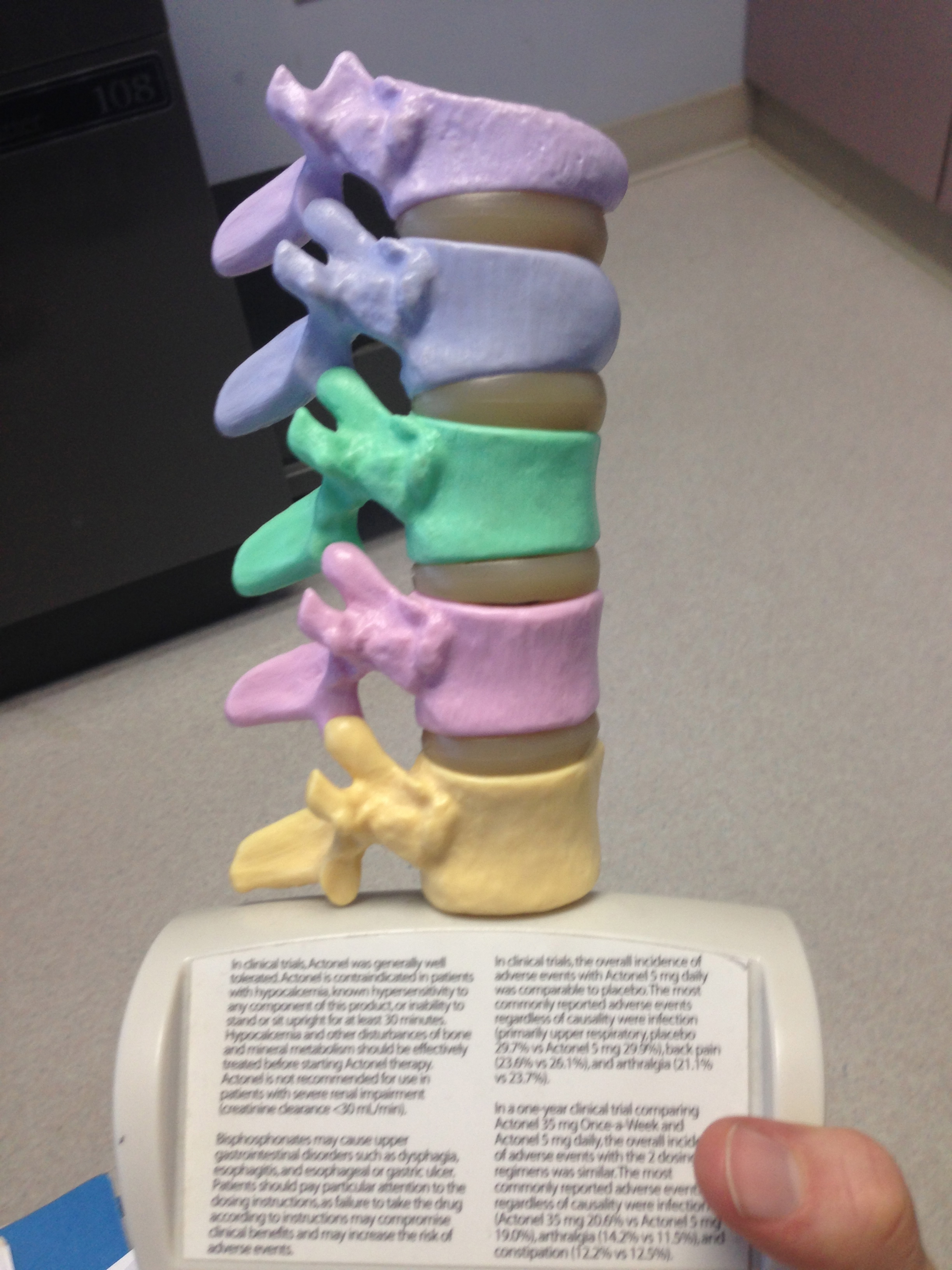Osteoporosis, and Why Your Bone Density Matters
I recently went through the statistics for search queries on the blog, and one that came up was "violin and osteoporosis," which I thought was worth addressing. We typically think of osteoporosis as something that old fragile ladies get, but frankly, it's something worth thinking about for both men and women, especially as we move past the peak bone density period of our twenties.
Simply put, osteoporosis is weakness of the bones, which causes them to be more brittle and susceptible to breakage. The precursor to osteoporosis is osteopenia, meaning low bone mass. Our bones are in a constant cycle of regrowth (ossification) and resorption (removal). These two processes remain in balance throughout our youth, but as we age, there is often more resorption, and less ossification. This is turn can cause a reduction in bone mass (osteoblast cells are less active than osteoclasts).
When I was at my doctor's office, I took a few pictures of this model spine, which shows a range of spinal issues. Focus on the bottom three, (green, pink, and yellow), which compares bone density for osteoporosis (green), osteopenia (pink), and normal (yellow) bones. Notice how large the porous surfaces are with the osteoporosis?
There are many factors that affect osteoporosis, from genetics, diet, and exercise, to hormonal levels due to cancer treatment, prescription medications, thryoid issues, or other endocrine dysfunction. Osteoporosis affects one in two women, and one in five men, so this is definitely not a ladies' disease. I became acquainted with osteopenia a few years ago when I was being treated for my pituitary adenoma (non cancerous pituitary tumor), which completely threw all of my hormones out of whack, essentially putting me into the hormonal cycle of menopause. Our sex hormones (as well as the hormone thyroxine) stimulate bone cell growth and osteoblast activity. This means that low estrogen and low testosterone negatively impacts your bone density, regardless of age or gender. This also means that if you have a thryoid issue (most commonly underactive thryoid or hypothyroidism), and you take medicine to balance your hormones and TsH (thryoid stimulating hormone), you are also at risk because the meds you take may either overbalance or underbalance said hormones. This is also true if someone has had hormonal treatment for cancer, i.e., hormone replacement therapy for breast cancer, ovarian cancer, etc. Osteoporosis is a definite secondary risk from many forms of cancer and subsequent treatment.*
*Quick aside: before I was diagnosed with my tumor two years ago, I knew very little about endocrinology. Now, a few MRI's, many articles, and many blood tests later, I know a bit more. I highly recommend learning about your own health issues as much as you can, so that you can have dialogues with your doctor about medicines, side effects, long term care, etc. It's made a HUGE difference in my treatment.*
This image is a bit more difficult to process, but do you see the shape of the vertebrae is actually different? The top four vertebrae are all compressed, whereas the healthy bone on the bottom is normal shaped and the disc isn't compressed either. The top two vertebrae are fractures (anterior wedge and compression) and green is osteoporotic and pink is osteopenic.
So why am I discussing this? Well, musicians (and frankly most people) tend to be sedentary (risk factor for osteoporosis) and our occupation forces us into a sitting situation for 6-8 hours a day. Our peak bone density occurs in our mid twenties, which means that most of you lovely readers have already peaked! As we begin to work towards our thirties, forties, fifties, sixties, and seventies, regardless of gender, we need to take care of our bones. In addition, many musicians don't challenge their upper body strength out of fear of injury which doesn't help muscle or bone strength. In looking at aging populations, one of the biggest risks is falling and balance, in conjunction with osteoporosis. Hip, wrist, and spinal fractures are a serious risk which could put a musician out of commission for months to a year. The good news is that bones also grow in response to mechanical stress, so daily exercise in a gravitational context (not swimming or cycling), walking, and weight bearing activities are really beneficial for your bones. Osteocytes build bone in response to stress of 72 seconds (according to Dr. Loren Fishman), so for example, if you hold a plank for 72 seconds, you are hypothetically fortifying your upper body bones. If you do standing lunges, squats, and other body weight exercises, you are also fortifying your bones. Since this is an isolating research study, I would imagine this applies to more dynamic movements such as walking, running, yoga, pilates, weight lifting, and all body weight activities. Biomechanist Katy Bowman writes that osteoporosis is not an all-body disease, but often restricted to specific location which also lacks movement and loading:
- Ribs(This could serious affect breathing, which is a major issue!)
- Wrists (If you're a musician, this is particularly scary)
- Vertebrae (Hello, back issues)
- Head of the femur (top of the thigh bone)
Image from: www.physioworks.com.au/
From a musician point of view, we want to keep our bones healthy and prevent fractures to our axial skeleton (spine, neck, sacrum, etc.) Healthy bones permit a long lifetime of music-making.
Want more resources?
Katy Bowman has a few great articles on osteoporosis as well as a great podcast on bones.
Buff Bones is a great exercise program developed by Rebekah Rotstein addressing osteoporosis and osteopenia.
Jill Miller writes on Osteoporosis
Yoga For Osteoporosis in the Huffington Post: I don't love the demo pictures in terms of alignment, but the content is solid.
Why Astronauts Get Osteoporosis, by Brooke Thomas (Also interesting to think about in the context of the film Gravity, and why it wouldn't be possible for Sandra Bullock to swim/crawl/etc)




